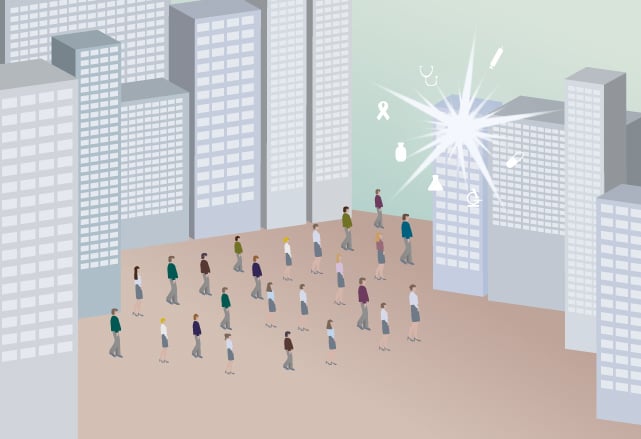Technology opens up new opportunities, and we expect implementation. Use of the new possibilities is now taken for granted in most parts of society. Banking, media, retail and education are just a few sectors that have been transformed by digitalisation and where use of artificial intelligence (AI) is applied. Healthcare, however, lags behind. The needs of healthcare have driven science and we have the tools for personalised medicine (PM). To reap the benefits of digitalisation and lay the foundation for personalised healthcare, now is the time to scale-up collaboration and enhance understanding of the different driving forces of industry, academia and healthcare.
Emerging technologies are those which are under rapid development and have the potential to dramatically change society. Examples of emerging technologies of today are AI, virtual reality (VR), augmented reality (AR) and Blockchain – technologies that are underway to change our society as we know it today and contribute to a sustainable development which also holds potential for healthcare. To deliver care that is safe and personalised, we need to allow these new technologies to enter healthcare. In order to get the full potential out of improved algorithms, methods and solutions, we need to modify the implementation process in healthcare and collaborate with the providers of the new solutions. Patients and healthcare professionals are ready for change, infrastructure may not always be. This is the prerequisite for personalised medicine and individualised care to become the norm.
Sweden has a tech savvy population of early adopters. Eight out of ten Swedes use digital identification services and 93% of the total population have access to internet at home (Statistics Sweden 2018). Today, Stockholm has 127 health tech companies (SSCI 2018) working on solutions and platforms for patients and healthcare. Some 40 of those companies are based at the H2 Health Hub, a coworking space for digital health. Additionally, Sweden is number one on the European Innovation Scoreboard (EWI 2018). Here, I will focus why the leap is still taking time and discuss possible approaches for the way ahead.
Incentives
Stockholm is one of the fastest growing metropolitan regions in Europe. The growth rate poses great opportunities, but also imposes challenges, especially for health and medical services. A well-developed healthcare system and a strong life science region with 50% of Sweden’s life science industry (SSCI 2017), make Stockholm region an ideal large-scale test bed for the development of the future’s more efficient and individualised healthcare. With personal identification numbers and health records we have been able to follow up and focus on personalisation in healthcare. The Swedish collaboration climate is highlighted as a competitive advantage as is our history of cross-disciplinary R&D collaborations. This makes Sweden an attractive ground for global actors.
Challenges
Innovation in healthcare is a broad scope. Products and services supporting patients, relatives or healthcare professionals can all be innovated, refined and remodelled to promote health. Region Stockholm, the county council responsible for healthcare in Stockholm, has set an innovation strategy with the goal to use innovation as a strategic tool to develop, streamline and quality assure healthcare. A strategy to minimise the tendency for initiatives to fade out after the test bed or pilot stage and improve new solutions for reaching the patient.
There are two types of challenges; structural and value based. The structural challenges are rigid or outdated reimbursement or compensation models; underdeveloped procurement models for health innovation; and weak economic incentives when the result does not benefit the originator directly. Value-based challenges are different organisational languages and culture, lack of trust as well as respect for the terms and incentives of other collaborators. New global tech companies are making an entry to the healthcare and now have healthcare providers as customers. In this new situation, cultural differences often result in linguistic confusion that make collaborations difficult.
Successes
Stockholm has the ambition to become a leading site for development and implementation of emerging technologies in healthcare focusing on individualised care. A couple of examples from the region are listed here:
Infrastructure for artificial intelligence in healthcare: The Karolinska University Hospital and Region Stockholm are jointly building an infrastructure to facilitate management and implementation of AI for diagnostics. Initially, focus is on image and function diagnostics. An example is assessment of X-ray images – demanding and time-consuming work where the use of AI can simplify and standardise the work significantly.
VR-based technology to treat mental unhealth: In a collaborative effort, researchers, doctors, film developers and VR-technicians have studied how VR can be used to treatment social phobia and panic disorders as a complement to cognitive behavioural therapy in primary care. Preliminary results are encouraging.
Augmented reality and 3D-images to support surgeons: Doctors at Karolinska University Hospital have performed spinal surgery using AR and 3D navigation technology. This is made possible using technology creating a high-resolution 3D image of the patient's spine combined with a video of the site of surgery. This way the surgical procedure can be planned virtually with great precision and also allow for enhanced control of the surgical instruments.
VR experiences for children in hospital care: Karolinska University Hospital is exploring the possibility to give children in hospital the opportunity to explore virtual worlds. The effect is young patients with increased mobility and motivation. Results show that after a VR experience, patients experience pain relief and children with difficulties moving are physically activated. The result is strengthened physical and mental health and improved quality of life.
Blockchain for safer handling of health data: There is a growing interest in Blockchain technology in the public sector with, among other things, a focus on how citizens can use their own health data in various digital solutions. Karolinska University Hospital is investigating use of Blockchain for safer handling and sharing of personal health data in highly specialised care. Blockchain enables work with distributed data that is owned and controlled by the individual as opposed to servers which store bulk data for populations.
H2 Health Hub – a coworking space for health tech: This co-working space and meeting place connects large companies and small innovators in health tech. Here, start-ups fast-track their business through an environment gathering highly motivated business builders to leverage their work through connection, collaboration and co-creation.
Innovation partnerships: Karolinska University Hospital has set up innovation partnerships through which large global companies can develop tomorrow's solutions for healthcare in a clinical environment, together with clinicians, patients and SMEs.
Looking ahead
In Stockholm, the region aims to further facilitate implementation of new technology in healthcare. Formation of a cohesive innovation system and more systematic implementation processes are examples of structures for that. An innovation hub with test beds at the university hospital is already in place as is the exploration of procurement of innovation.
The route to success is through collaboration, thus the most important step is to build trust in partnerships between industry – both global corporations and SMEs – and healthcare. The Karolinska University Hospital has ambitions to do that through the above-mentioned innovation partnerships. This is one way to initiate dialogue and to overcome cultural barriers between industry and healthcare and focus on the needs. Mutual visions and goals and an acceptance of actors different driving forces are the pillars of trust. With that in place, joint focus can be on delivery of equal, personalised healthcare.
Key points
- Banking, media, retail and education have been transformed by digitalisation but healthcare lags
- Challenges facing collaborators are structural and value based
- Stockholm is fostering trust between industry and healthcare to develop personalised healthcare
- The time is ripe to scale-up collaboration to develop personalised healthcare




